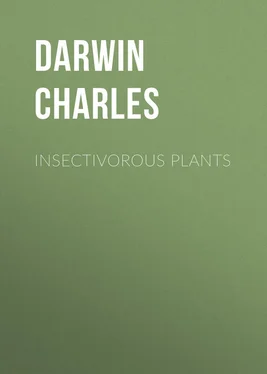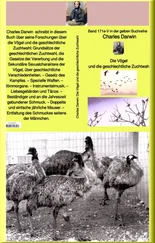Charles Darwin - Insectivorous Plants
Здесь есть возможность читать онлайн «Charles Darwin - Insectivorous Plants» — ознакомительный отрывок электронной книги совершенно бесплатно, а после прочтения отрывка купить полную версию. В некоторых случаях можно слушать аудио, скачать через торрент в формате fb2 и присутствует краткое содержание. Жанр: foreign_antique, foreign_prose, на английском языке. Описание произведения, (предисловие) а так же отзывы посетителей доступны на портале библиотеки ЛибКат.
- Название:Insectivorous Plants
- Автор:
- Жанр:
- Год:неизвестен
- ISBN:нет данных
- Рейтинг книги:5 / 5. Голосов: 1
-
Избранное:Добавить в избранное
- Отзывы:
-
Ваша оценка:
- 100
- 1
- 2
- 3
- 4
- 5
Insectivorous Plants: краткое содержание, описание и аннотация
Предлагаем к чтению аннотацию, описание, краткое содержание или предисловие (зависит от того, что написал сам автор книги «Insectivorous Plants»). Если вы не нашли необходимую информацию о книге — напишите в комментариях, мы постараемся отыскать её.
Insectivorous Plants — читать онлайн ознакомительный отрывок
Ниже представлен текст книги, разбитый по страницам. Система сохранения места последней прочитанной страницы, позволяет с удобством читать онлайн бесплатно книгу «Insectivorous Plants», без необходимости каждый раз заново искать на чём Вы остановились. Поставьте закладку, и сможете в любой момент перейти на страницу, на которой закончили чтение.
Интервал:
Закладка:
Several eminent physiologists have discussed the homological nature of these appendages or tentacles, that is, whether they ought to be considered as hairs (trichomes) or prolongations of the leaf. Nitschke has shown that they include all the elements proper to the blade of a leaf; and the fact of their including vascular tissue was formerly thought to prove that they were prolongations of the leaf, but it is now known that vessels sometimes enter true hairs. The power of movement which they possess is a strong argument against their being viewed as hairs. The conclusion which seems to me the most probable will be given in Chap. XV., namely that they existed primordially as glandular hairs, or mere epidermic formations, and that their upper part should still be so considered; but that their lower part, which alone is capable of movement, consists of a prolongation of the leaf; the spiral vessels being extended from this to the uppermost part. We shall hereafter see that the terminal tentacles of the divided leaves of Roridula are still in an intermediate condition.
The glands, with the exception of those borne by the extreme marginal tentacles, are oval, and of nearly uniform size, viz. about 4/500 of an inch in length. Their structure is remarkable, and their functions complex, for they secrete, absorb, and are acted on by various stimulants. They consist of an outer layer of small polygonal cells, containing purple granular matter or fluid, and with the walls thicker than those of the pedicels. Within this layer of cells there is an inner one of differently shaped ones, likewise filled with purple fluid, but of a slightly different tint, and differently affected by chloride of gold. These two layers are sometimes well seen when a gland has been crushed or boiled in caustic potash. According to Dr. Warming, there is still another layer of much more elongated cells, as shown in the accompanying section (fig. 3) copied from his work; but these cells were not seen by Nitschke, nor by me. In the centre there is a group of elongated, cylindrical cells of unequal lengths, bluntly pointed at their upper ends, truncated or rounded at their lower ends, closely pressed together, and remarkable from being surrounded by a spiral line, which can be separated as a distinct fibre.
These latter cells are filled with limpid fluid, which after long immersion in alcohol deposits much brown matter. I presume that they are actually connected with the spiral vessels which run up the tentacles, for on several occasions the latter were seen to divide into two or three excessively thin branches, which could be traced close up to the spiriferous cells. Their development has been described by Dr. Warming. Cells of the same kind have been observed in other plants, as I hear from Dr. Hooker, and were seen by me in the margins of the leaves of Pinguicula. Whatever their function may be, they are not necessary for the secretion of a digestive fluid, or for absorption, or for the communication of a motor impulse to other parts of the leaf, as we may infer from the structure of the glands in some other genera of the Droseraceae.
The extreme marginal tentacles differ slightly from the others. Their bases are broader, and besides their own vessels, they receive a fine branch from those which enter the tentacles on each side. Their glands are much elongated, and lie embedded on the upper surface of the pedicel, instead of standing at the apex. In other respects they do not differ essentially from the oval ones, and in one specimen I found every possible transition between the two states. In another specimen there were no long-headed glands. These marginal tentacles lose their irritability earlier than the others; and when a stimulus is applied to the centre of the leaf, they are excited into action after the others. When cut-off leaves are immersed in water, they alone often become inflected.
The purple fluid or granular matter which fills the cells of the glands differs to a certain extent from that within the cells of the pedicels. For when a leaf is placed in hot water or in certain acids, the glands become quite white and opaque, whereas the cells of the pedicels are rendered of a bright red, with the exception of those close beneath the glands. These latter cells lose their pale red tint; and the green matter which they, as well as the basal cells, contain, becomes of a brighter green. The petioles bear many multicellular hairs, some of which near the blade are surmounted, according to Nitschke, by a few rounded cells, which appear to be rudimentary glands. Both surfaces of the leaf, the pedicels of the tentacles, especially the lower sides of the outer ones, and the petioles, are studded with minute papillae (hairs or trichomes), having a conical basis, and bearing on their summits two, and occasionally three or even four, rounded cells, containing much protoplasm. These papillae are generally colourless, but sometimes include a little purple fluid. They vary in development, and graduate, as Nitschke 3 3 Nitschke has elaborately described and figured these papillae, 'Bot. Zeitung,' 1861, pp. 234, 253, 254.
states, and as I repeatedly observed, into the long multicellular hairs. The latter, as well as the papillae, are probably rudiments of formerly existing tentacles.
I may here add, in order not to recur to the papillae, that they do not secrete, but are easily permeated by various fluids: thus when living or dead leaves are immersed in a solution of one part of chloride of gold, or of nitrate of silver, to 437 of water, they are quickly blackened, and the discoloration soon spreads to the surrounding tissue. The long multicellular hairs are not so quickly affected. After a leaf had been left in a weak infusion of raw meat for 10 hours, the cells of the papillae had evidently absorbed animal matter, for instead of limpid fluid they now contained small aggregated masses of protoplasm, which slowly and incessantly changed their forms. A similar result followed from an immersion of only 15 minutes in a solution of one part of carbonate of ammonia to 218 of water, and the adjoining cells of the tentacles, on which the papillae were seated, now likewise contained aggregated masses of protoplasm. We may therefore conclude that when a leaf has closely clasped a captured insect in the manner immediately to be described, the papillae, which project from the upper surface of the leaf and of the tentacles, probably absorb some of the animal matter dissolved in the secretion; but this cannot be the case with the papillae on the backs of the leaves or on the petioles.]
Preliminary Sketch of the Action of the several Parts, and of the Manner in which Insects are Captured.
If a small organic or inorganic object be placed on the glands in the centre of a leaf, these transmit a motor impulse to the marginal tentacles. The nearer ones are first affected and slowly bend towards the centre, and then those farther off, until at last all become closely inflected over the object. This takes place in from one hour to four or five or more hours. The difference in the time required depends on many circumstances; namely on the size of the object and on its nature, that is, whether it contains soluble matter of the proper kind; on the vigour and age of the leaf; whether it has lately been in action; and, according to Nitschke, 4 4 'Bot. Zeitung,' 1860, p. 246.
on the temperature of the day, as likewise seemed to me to be the case. A living insect is a more efficient object than a dead one, as in struggling it presses against the glands of many tentacles. An insect, such as a fly, with thin integuments, through which animal matter in solution can readily pass into the surrounding dense secretion, is more efficient in causing prolonged inflection than an insect with a thick coat, such as a beetle. The inflection of the tentacles takes place indifferently in the light and darkness; and the plant is not subject to any nocturnal movement of so-called sleep.
Интервал:
Закладка:
Похожие книги на «Insectivorous Plants»
Представляем Вашему вниманию похожие книги на «Insectivorous Plants» списком для выбора. Мы отобрали схожую по названию и смыслу литературу в надежде предоставить читателям больше вариантов отыскать новые, интересные, ещё непрочитанные произведения.
Обсуждение, отзывы о книге «Insectivorous Plants» и просто собственные мнения читателей. Оставьте ваши комментарии, напишите, что Вы думаете о произведении, его смысле или главных героях. Укажите что конкретно понравилось, а что нет, и почему Вы так считаете.












